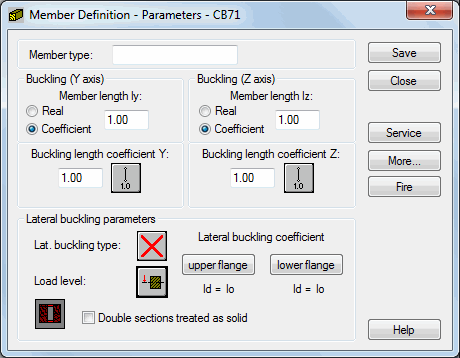Click Parameters in the Definition dialog or select New Member Type located in the Timber Member Type dialog to define timber member type parameters for the French code CB71. The following timber codes are also available: Eurocode 5, French Eurocode 5, Finnish Eurocode 5, and Polish code PN-B-03150:2000.

The name of the selected timber member type is given in the member type field (any may be entered). Define the length of the member for the appropriate plane in the fields Buckling with respect to axis Y or Z. Two methods of assigning this length are possible.
- Select Real option and the entered value is interpreted directly as the length.
- Selecting the Coefficient option and the value is interpreted as a coefficient through which the actual member length should be multiplied to obtain the appropriate value. Entering the 0.25 value means the appropriate value is equal to 1/4 of the actual length.
The second (coefficient) method is very useful to simultaneously define several members whose actual lengths differ. If the set parameters are to be retained as a category entering the length in this way is necessary. Entering 1.0 guarantees that each member defined with Ly will have its actual length accepted.
The buckling length coefficients of the member may be defined in both directions in the Buckling Length Coefficient field. The actual member length is automatically entered in either field (or the sum of the component member lengths).
The buckling length coefficient depends on the support conditions of the member end nodes. The buckling length of the member may also be defined in the Buckling Models dialog, opened by the schematically representative button of the selected buckling model type. Typical member support types defined by the code are located there and once selected, the coefficient value will be accepted or calculated automatically. Buckling is always included in the calculations if a compression force is present in the member, even if it is negligible in relation to other internal forces. To eliminate buckling effects from the calculations, the last button must be selected from the Buckling Model, ignoring buckling in the calculation process.
Lateral buckling type, load level, and lateral buckling length coefficients are used during the verification of lateral buckling of the member and may be selected in the Lateral Buckling Parameters field.
The Lateral Buckling Type defines the appropriate lateral buckling code parameters depending on the static bar model. In accordance with the code requirements, one of the models included in the code should be accepted. Model buttons reflect the corresponding code positions. The last of which ignores the lateral buckling effects during calculations.
To define lateral buckling conditions, it is also necessary to provide the load application level. The ordinate height of the load application is defined in the bar section axis. Assuming that lateral buckling occurs when loading the bar in the XZ plane, only the relative value in the interval <-1.0,1.0> coordinate needs to be entered. It is the. If the load is applied in a characteristic section point (upper shelf, lower shelf, and others) it is enough to select the appropriate button. The coordinate value will be accepted automatically.
Lateral Buckling calculations necessitate providing lengths for the bar section secured against torsion (lateral buckling). Due to the possibility of attaching the upper shelf and the lower shelf separately and the compressive stresses in the upper or lower shelf in various load cases, two lateral buckling lengths are accepted. Coefficients, through which the base bar length should be multiplied to obtain the lateral buckling length Lz, are taken as the base length. The coefficient value may be added directly or the button with the typical attachment case may be selected.
Click More button to define the remaining bar type parameters described in the code, such as: load type, section parameters, and dampness change.
Click Service button to define the parameters of bar type, such as: limit displacements, and initial deflection.
Click Member Definition - Fire (CB71) button to define the fire rating parameters of a given bar type.
Click Add to add a bar type, name, and parameters to the list of previously defined timber bar types.